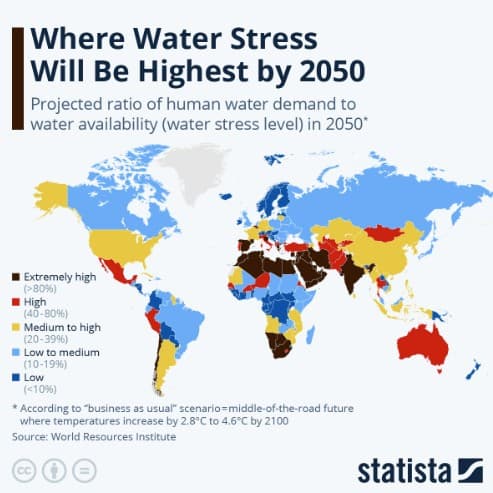November 22, 2025 | 19:44 GMT +7
November 22, 2025 | 19:44 GMT +7
Hotline: 0913.378.918
November 22, 2025 | 19:44 GMT +7
Hotline: 0913.378.918

Water is not only the basis of life for animals and plants, but is also likely to become a contested resource in parts of the world in the coming decades. According to UN figures, global water stress, i.e. the proportion of water withdrawn for use in industry, agriculture or private households in relation to available water, was manageable at 18.2% in 2020. In 2022, however, 2.4 billion people were living in areas that are exposed to extreme water stress in some cases.
It is not possible to determine exactly how high this will be by 2050 due to numerous factors such as the global population or economic and political developments in emerging and transition countries. This is why scientists are currently working with scenarios instead of more precise estimates. However, it is certain that the demand for water will increase steadily and that many countries are already consuming more than they have available.
As Statista's Martin Armstrong shows in the infographic below, based on projections by the World Resources Institute (WRI) , 51 of the 164 countries and territories analyzed are expected to suffer from high to extremely high water stress by 2050, which corresponds to 31 percent of the population.
According to WRI, the scenario used corresponds to a "business as usual" future with temperature increases of between 2.8 and 4.6 degrees Celsius by 2100 and a world that remains unequal. In addition to the entire Arabian Peninsula, Iran and India, most North African countries such as Algeria, Egypt and Libya are among the countries that are expected to consume at least 80 percent of the available water by 2050.
However, the phenomenon of water scarcity is not limited to emerging countries. Southern European countries such as Portugal, Spain and Italy are also reportedly already under high water stress, and the situation in Spain is set to worsen significantly by 2050. For France and Poland, the WRI experts assume medium to high water stress, which corresponds to a consumption rate of 20 to 40 percent of available resources.
(OP)

(VAN) In a new study published in Trends in Biotechnology, researchers used a gene-editing technology called CRISPR to increase a fungus's production efficiency and cut its production-related environmental impact by as much as 61%- all without adding any foreign DNA.

(VAN) A top official in Beijing’s Cop delegation says China is committed to clean energy – but US’s absence is a problem.

(VAN) The Bangsamoro region’s inflation rate rose slightly to –1.3 percent in October 2025 from –1.5 percent in September, the Philippine Statistics Authority (PSA-BARMM) reported.

(VAN) FAO-led report says protecting and restoring forests is crucial to boosting climate-resilient agriculture, rural livelihoods and global food and water security.

(VAN) Flagship partnership secures additional GBP 16.9 million to strengthen forest monitoring, transparency and country support to 2030.

(VAN) After a turbulent year for international development, the aid and assistance landscape has shifted, with donors rethinking how, where and why they support sustainable development.

(VAN) A new tool for measuring the economic value of farm animal welfare improvements has been developed, potentially transforming how consumers, retailers and the government evaluate animal welfare policies.